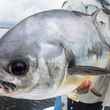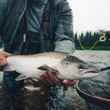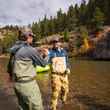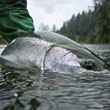It was brutally cold last week here in eastern Idaho and on the rivers of Yellowstone Country. One night last week, I huddled next to the fire inside while, outside, the mercury bottomed out at minus-22 degrees. It’s a bit early to be seeing such cold weather, but if you’re going to fish in the fall in the northern Rockies, you better be prepared for it.
And this time of the year is a great time to be out chasing trout. Winter doesn’t have to get in the way of that.
Browns are in the midst of the fall run, and on rivers like the Madison, rainbows are running up out of Hebgen Lake, fattening up on eggs. Some of those fish will spend all winter in the Madison inside the boundaries of Yellowstone National Park—kind of like steelhead, these rainbows will overwinter in the river and then spawn in the early spring before heading back to the lake once the weather and the water warms up a bit.
On rivers like the Henry’s Fork and the South Fork, trout are feeding on top, eating Blue-winged Olives and dining on epic midge hatches. Browns are aggressively protecting redds, and while fishing to spawning trout is frowned upon, chasing browns that aren’t on redds can be great with big, gaudy streamers.
But you better know how to stay warm. Iced fly-rod guides are one thing … but hypothermia is something else altogether.
If you’re a die-hard angler who has fished through single-digit temperatures, you understand how important staying warm is. If you’re winter-curious when it comes to fly fishing, ensuring you’re warm is probably the most important thing you can do.
Here are some tips:
- If you want to stay warm, you need to stay dry. Yes, it might seem like a no-brainer, but even the smallest leak in your waders can be a real problem in the winter. Water temperatures aren’t usually much warmer than freezing, and the smallest trickle can soak even the warmest wool sock and end your day sooner than you might like. Before you go fishing, make sure your waders are going to hold up. Consider, too, the need to keep your hands dry, which is no easy task when, especially if you’re catching and releasing trout. I always keep a dry hand towel in the pocket of my wading jacket so I can dry my hands after releasing a fish.
- Keep your extremities warm. Your feet and your hands (and your ears and your nose) often bear the brunt of cold weather when you’re fishing. Warm socks are a must—I almost always use wool socks under my waders when I fish in the winter—and gloves are often necessary. Wool dries quicker than other materials, but the general rule is best described by knowing your ABCs. If you only take one thing away from this tip, here it is: Anything But Cotton (ABC). Cotton soaks quickly, dries slowly and should not be worn next to your body when you’re fishing in the winter.
- During cold weather, we lose most of our body heat through our heads. A wool cap or ski cap is a great idea. A Buff or similar cover or mask can supplement your lid and help you retain heat.
- Hand warmers that can be activated when you open them are a good idea, but don’t put them under your gloves. Rather, put them in the pockets of your coat or jacket—this way, if your gloves or mittens get wet, you have a way to warm up your fingers. On the flip side, it’s never a bad idea to put hand warmers near your feet, perhaps under your wool socks.
- Again, following the simple ABC rule, consider fleece or microfleece upper and lower garments. I have three pairs of fleece pants, each a different thickness. If it’s going to be really cold, I wear the thickest pair under my waders. For warmer winter days, thinner fleece.
- Drink plenty of water, even if the water isn’t warm. Hot tea and hot coffee can be helpful, but both are diuretics, meaning you may have to get out of the water more often to answer nature’s call. Hot alcoholic beverages? Avoid them, or wait until you’re back at the car or truck. While it may feel warm going down, alcohol can actually lower your body’s core temperature.
- If you can, get out of the water now and then. Even with waterproof waders and wool socks, standing in near-freezing water is going to take a toll on your body heat. Step out of the water now and then.
- Layers matter, and not just because they keep you warmer. Layers make it possible to regulate your body temperature. If you’re too warm, you’ll sweat, and if it gets colder, sweating can actually make you colder, too. Be able to add or remove layers as the day goes on. You’ll be more comfortable and you’ll be able to fish longer.
- Have some sunshine? Soak it up. Wear darker colors that transfer that solar heat to your body.
- On really cold days, cover as much of your skin as you can. Exposed skin gets cold quickly, and overexposure can lead to hypothermia or even frostbite.
- When you can, always fish with a buddy in the winter. Not only can it be more fun, but if you take a tumble and fall into the ice-cold river, you’ll have somebody there who can help drag you out, and to help you get warm once you’re out of the water.
- Have what it takes to build a fire on the fly. Even just some fire-starting material and a Bic lighter is worth taking along in your fishing vest. If you or a buddy takes a dunk, and you’re not near your car or truck, a streamside fire could be what saves your life. And, honestly, a fire is always nice to warm up by on a cold day.
These may sound like elementary ideas to keep you comfortable when it’s cold outside, and, honestly, they are. But it’s not just comfort you’re after when you fly fish in the winter. It’s safety.
Being able to enjoy the endeavor rather than dread it is important, particularly if chasing trout in the winter is something new for you. And, if you’re an experienced winter angler, make sure your fishing buddies who don’t have winter-fishing chops are doing their best to stay warm. You want them to enjoy the experience, not try it and hate it.
































Comments
Kirk miller replied on Permalink
I just got off a 5 day float/fish/camp down the South Fork Canyon, which we delayed by 2 days to avoid camping in below zero weather (first good decision). Your suggestions are all good; I would add under item 1 ; make sure you have a wading belt and pull it snug as high as you can on your chest. I slipped and sat down and took on water down the back, due to a loose belt. I had a cold butt and feet the rest of the day and spent 3 hours that night drying the inside of my waders without burning a hole in them. A little propane heater was much better than our camp fire for this purpose. A second set of long johns, fleece, gloves, etc. is also valuable; they allowed me to continue to fish until I got everything dried out the second evening.
Glenn Dotter replied on Permalink
Good article. First one that didn't tell you you had to spend a fortune to stay warm. Just what to do, what to have, and what type of materials work well. Best advice is go with a buddy and carry a set of dry clothing in your vehicle just in case, and have the means to get warm in a hurry.
Kyle Danielis replied on Permalink
I’d say add some cleats to your wading boots for help on the ice and rocks.
Glenn L replied on Permalink
Great article and advice. The only things I might add are;
(1) a fleece cap works well too. In my experience it dries faster than wool.
(2) bring a dry bag to stow the layers when you feel yourself starting to sweat.
(3) water is good to keep you hydrated, hot water is better to help restore your core temp when you feel your extremities cooling
(4) I prefer very thin wool gloves when I feel my hands beginning to chill. Cabelas’s sells a wool liner glove that works great for me.
(5) wear a baclava to keep your head and neck warm. When you start to chill, pull the face piece over your mouth and it will slow heat transfer to the colder air.
Pages